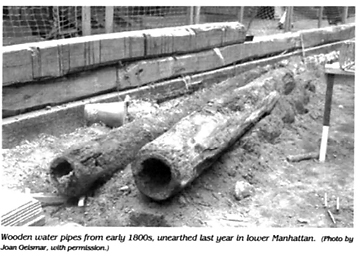

In the late afternoon of last October 21st at Coenties Slip and Water Street in Manhattan, a backhoe operated by a Parks Department contractor struck something hard and unexpected, four feet belowground. It hit what appeared to be a tree trunk, lying on Its side. A supervisor phoned urban archeologist Joan Geismar, a consultant on buried things of possible significance. Geismar arrived on the scene early the next morning to find the trunk dug up: a 10-foot log fragment apparently hollow but filled with dirt. Geismar began exploring. Gradually, she scraped clean the upper edge of another log, this one over 13 feet long; connected to it was another log a few Inches longer. To the untrained eye, these logs were perhaps remnants of some derelict building. Geismar recognized them as water pipes, among the City's first The 13-footers, laid in the ground beneath Coenties slip 200 years ago, are the most remarkable of their sort ever discovered intact.
In the summer of 1798, New York, a City of 60,000 people expanding rapidly up Manhattan from its southern tip, experienced a devastating yellow fever epidemic in which 2,000 people died. Doctors theor1zed that the disease was transmitted by miasmas of bad air rising from the town's swampy fringes and filthy streets (the real agent of death was infected mosquitoes breeding in those places). The suggested cure: piping abundant fresh water from the pristine Bronx River. This would banish disease and end generations of reliance on the distasteful, insufficient and increasingly polluted wells for which New York was infamous. With the city's consent the state legtislature In 1799 chartered the Manhattan Company, ostensibly a business to purify New York's water supply. The company founder was Aaron Burr, much less interested in water than banking. Before supplying water, Burr's company opened a bank, the pioneering financial institution recently known as Chase Manhattan, now J. P. Morgan Chase.
As a water provider, the Manhattan Company was a dismal failure. Instead of channeling a mainland river, the company built a meager waterworks - well, pump, and small reservoir - on suburban Chambers Street and laid a haphazard network of yellow pine pipe down to the town. Sometime before 1808, the company placed the Coenties Slip line: 30 inches around, with a narrow six-inch bore. The 25 customers who tapped it with even smaller service pipe were likely no better served than others whose complaints of dry cocks and empty promises resound in contemporary newspapers, letters, and diaries.
Manhattan Company claims of monopoly water rights (on which its banking privileges depended) suppressed New York's water fortunes through decades of disease and fire until the city built its own Croton Aqueduct, which brought northern Westchester river water beginning in 1842. Croton became the model for public urban water supplies and the origin of New York's now vast modern supply, run today by the city Department of Environmental Protection. The Manhattan Company quietly abandoned its water operations, and eventually got a banking charter.
For most of the past century and a half, New York's buried wooden pipe has rotted away. or been dug up and discarded in the course of construction excavations. Some gets sliced up as souvenirs for contractors, officials, collectors, and bank branches. City museums have bits of pipe, short pieces mostly in storage or sidehall displays. Nothing like the Coenties Slip pair - unique In their original length and coupling and excellent condition has ever been presented and displayed intact. Inefficient though they might have been in use, these post -colonial pipes of slender pine are the City's oldest surviving infrastructure.
Days after their discovery, the pipes were dug up and, along with the shorter section, taken to a conservator in New Jersey. There they have begun a year-long preservative bath in polyethylene glycol before freeze-drying at another facility. All of this is happening through a collaboration as rare as the pipes themselves. A group of public agency representatives (Department of Environmental Protection, Parks Department, Landmarks Preservation Commission, Municipal Archives), individuals with expertise in the subject, the pipe conservator, cultural institutions and others has been meeting since November.
We have agreed that the pipes should be preserved and publicly displayed together. The question we are now gappl1ng with is how and where to display them. Together, they weigh 1,600 pounds: aligned to accentuate the point at which they connect they stretch nearly 30 feet. In the months ahead, as the pipes are prepared for their reentry into modern New York, our surrogate group will continue the effort to find them a good home. Gerard Koeppel is the author of Water for Gotham (2000, Princeton University Press). Portions of this article appeared under the title "Pipe Dreams" in The New York Times, March 13, 2005.

